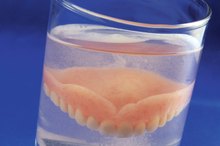Adverse Effects of Gold Caps in Teeth
Gold has been the most commonly used dental component for caps and fillings in teeth, mainly because gold is easy to form, strong and lasts indefinitely. It became a status symbol of wealth and distinction and still maintains that symbolic meaning to many cultures and groups of people today. However, because many people prefer to have a smile that reveals natural white teeth instead of gold caps, gold dental work is being replaced with porcelain and newly enforced resin. Gold is still being used in caps for back teeth because of its strength and durability; however, some adverse effects are being discovered that could result in gold being eliminated altogether.
Mercury Exposure
A hidden danger that has become a concern to some patients is that the mercury can slowly be released from the amalgam fillings that are under the gold caps. This can occur when a person chews, swallows, drinks, grinds her teeth or breathes. The ionized mercury can be absorbed by the syliva, tooth pulp and gum tissues and deposited into the linings of the digestive system and then into the blood stream. The American Dental Association has argued for years that when the mercury used in the fillings hardens, it is safe for the patient. The gold cap on its own does not contain mercury, nor does it wear down to expose the mercury that's in the filling. In fact, it's because the cap or crown remains whole that the actual issue of exposure might not be noticed. Underneath the gold crown, the rest of the tooth and the root can begin to slowly corrode over time, making it possible for the mercury to be exposed to the body. Since mercury does not exit the body through excrement, it lodges inside organs and brain cells and destroys them.
- A hidden danger that has become a concern to some patients is that the mercury can slowly be released from the amalgam fillings that are under the gold caps.
- The gold cap on its own does not contain mercury, nor does it wear down to expose the mercury that's in the filling.
MRI
How to Change the Color of Dental Crowns
Learn More
A person who has a gold cap and who will be undergoing an MRI should tell the radiologist that he has a gold cap in his mouth. Where there is no absolute danger to the patient and no probability of problems stemming from it, he will likely experience a tingling sensation in their mouth during the scan, which could cause him to panic and move around while undergoing the test. Additionally, the results of the scan will be poor because the metal in the mouth will distort the actual reading, which could be problematic in getting the correct results for other issues that require the accuracy of the MRI scan.
Cosmetic Need
Throughout history, the twinkle of a gold cap that was easily seen through a smile represented prosperity, and many people were proud to show them off. That symbolic gesture has never been totally replaced because cultures and groups of people still prefer to have a visible gold cap in their mouths. Yet with the modern-day preference being a full set of solid, white teeth through a smile, the presence of a gold cap to some is dated evidence that reveals their age or their inability to maintain healthy teeth. And even though some dentists still prefer to use gold caps in back teeth, vanity dictates to many people that all the teeth be white.
- Throughout history, the twinkle of a gold cap that was easily seen through a smile represented prosperity, and many people were proud to show them off.
- Yet with the modern-day preference being a full set of solid, white teeth through a smile, the presence of a gold cap to some is dated evidence that reveals their age or their inability to maintain healthy teeth.
Related Articles
References
- Clark P, Tugwell P, Bennet K, et al. Injectable gold for rheumatoid arthritis. Cochrane Database Syst Rev. 2000;1997(2):CD000520. doi:10.1002/14651858.CD000520
- Johns Hopkins Arthritis Center. Rheumatoid Arthritis Treatment: Gold.
- University of Washington Medicine. Gold treatment.
- Joshi P, Dhaneshwar SS. An update on disease modifying antirheumatic drugs. Inflamm Allergy Drug Targets. 2014;13(4):249-61. doi: 10.2174/187152811304140915152102
- Singh JA, Saag KG, Bridges SL Jr, et al. 2015 American College of Rheumatology Guideline for the Treatment of Rheumatoid Arthritis. Arthritis Rheumatol. 2016;68(1):1-26. doi:10.1002/art.39480
- Klinkhoff A. Major side effects of gold therapy. UpToDate.
- Mayo Clinic. Nickel allergy.
- Drug Shortage Canada. Drug Shortage Report for MYOCHRYSINE. Updated June 10, 2020.
- U.S. National Library of Medicine: MedlinePlus. Auranofin. Updated June 24, 2020.
- Mayo Clinic. Gold compound (oral route, parenteral route). Updated February 1, 2020.
Writer Bio
Ronnie Dauber is a Canadian author with six books published to date, and has been a professional writer online since 2007. She holds three college diplomas in children's and adult literature and one college diploma in business administration and common law.







